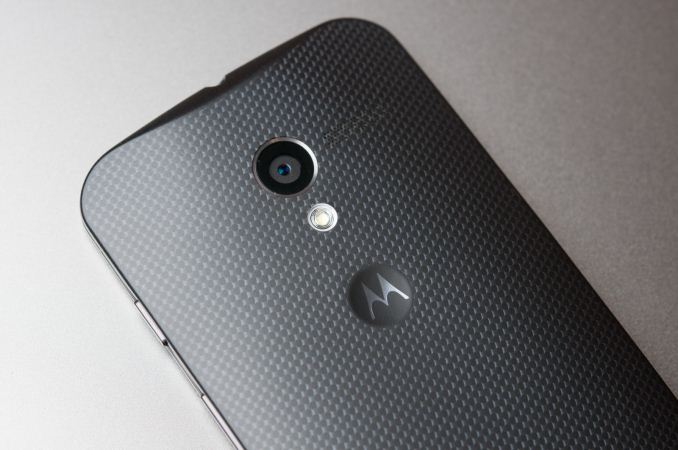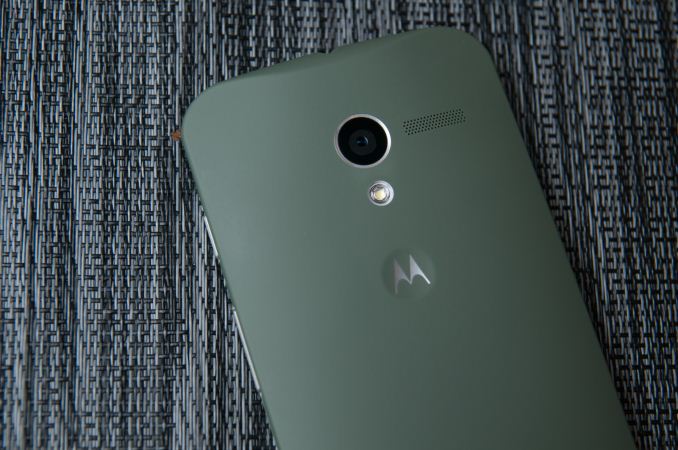Moto X Review
by Brian Klug on August 26, 2013 1:30 PM EST- Posted in
- Smartphones
- Qualcomm
- MSM8960
- Motorola
- Android
- Mobile
- Android 4.2
- Moto X
Final Thoughts & Conclusion
Prior to the Moto X, since being acquired by Google, the execution strategy for Motorola wasn't entirely clear. Google talked about there being a firewall between the two companies, and Motorola described its own situation as being analogous to YouTube's. The first result of that strategy is effectively a re-launch of the mobile part of Motorola, and its first device, the Moto X.
I finish the Moto X review feeling very differently about the device than I did initially, in a positive way. I have to admit that I went into the Moto X review very skeptical for a few reasons. Initially the amount of hype surrounding the Moto X was somewhat off-putting, as if many expected the Moto X to instantly eclipse Nexus and all other Android phones entirely because of the Google involvement. The second thing was the weird octacore messaging and dilution of the word "core" even further, and the SoC choice itself, but I understand better now the choices behind that platform and messaging. While there's still no getting around the fact that having a dual core SoC in a world of quad core devices is difficult to explain away, in this case having 8960Pro with two CPU cores helps Motorola run them at higher frequency more of the time versus the throttling that goes on with current 28nm LP quad core parts. The other performance aspect is obviously how using F2FS helps the Moto X have comparatively very fast random read and write performance, and storage I/O will start to become a big consideration for performance.
The features Motorola has enabled through the addition of a TI MSP430 for sensor fusion (its contextual awareness processor) and TI C55x family DSP (its natural language processor) are indeed major unique and novel features for the Moto X. Active display is probably my favorite feature out of the things enabled by the X8 Mobile Computing System and the combination of these two extra TI components (err... "cores"). It's useful for quickly being able to just glance at what's new or why your phone vibrated in your pocket, or if it even vibrated at all. It also is perhaps one of the best uses of AMOLED I've seen, for doing something other than just displaying a clock and battery status when the phone is in standby.
The other two features are novel but not something I can't live without. Touchless control works, but I still think that if you're within speaking distance of your Moto X you probably could just pick up the phone and use it. The upside is that the feature doesn't affect battery life (I tested with it enabled and disabled) and can be convenient, the downside is that activate on voice still has some false positives. Likewise, the camera activation gesture definitely has some false positive issues and occasionally presents me with a gallery page full of photos of the inside of my pocket. Launching the camera that way is more natural than I thought it would be, so I still use it, but occasional activation in your pocket is just something to be wary of.
Including a primarily stock UI is also a huge step in the right direction, and perhaps the most positive result of the Google interaction. With Android 4.x, the platform really doesn't need much custom tailoring and smoothing over except for the camera UI. Being able to use the stock UI makes the Moto X feel almost like the Google Play edition HTC One and SGS4 I was used to before switching to the Moto X. The ability to use the stock UI will be a huge selling point for users who are on CDMA networks (and refuse or unable to switch) and can't use a Nexus or GPe phone.
The Moto X is an interesting flagship product thanks in part to its smaller size and shape. There's a market out there for a flagship smartphone that isn't gigantic, and at present it's really served almost entirely by the iPhone. While I have gotten gradually used to larger and larger phones, I have to admit it is refreshing to use the Moto X and I have an easier time doing one-handed swipe typing on the Android keyboard and navigating around apps. The rounded shape and lack of cheap-feeling glossy plastic really helps the Moto X feel like a premium smartphone.
The Moto X is without a doubt the closest thing we have in the Android handset space to a smaller flagship device - one that isn't positioned as a midrange phone against a larger hero device. I've described the Moto X as being on the smaller side, but it still includes a relatively large 4.7-inch display, the Moto X just wastes less of the space around that display.
While Motorola suffered a few hiccups with Moto Maker and getting our Moto Xes out on time, I have no doubt the build-your-own customization aspect of the device will be very popular. I'm very pleased with how my device turned out, and having something which looks different, and I specified, really does make me want to use it more. I'm still more excited about the upcoming wood-backed options as well, I just wish they were available at launch and not coming some time in Q4 2013.
The camera on the Moto X nails it on paper – it's a comparively big sensor, with 1.4µm pixels instead of the 1.1µm kind that has been the industry trend, and F/2.4 optics. In practice however the Moto X camera has somewhat bimodal behavior – it can be good, it also can be bad, and a lot of that comes from the clear pixel color filter array which trades off some resolution for sensitivity and introduces color artifacts. In bright scenes I saw some great results from the Moto X camera, but indoors and in darker scenarios the device seems to use different processing that changes behavior entirely. Motorola deserves credit for doing something different, however.
The Moto X does a lot of things right – the size, shape, stock UI, customization. I enjoy using the Moto X a lot more than I thought I would, and think Motorola hit a home run with the Moto X in the size and shape department. Its only Achilles heel is its price, which comes in at $199 on a 2 year contract and $579 off contract at AT&T. There's still no word on Google Play edition or Developer Edition pricing, but I expect they'll be around the same. I still feel like that's too high considering the platform choices, although I expect the Moto X will come down in price pretty rapidly once MSM8974 phones start hitting the market. At the right price the Moto X could be a very big deal, almost disruptive. It's just a matter of getting it there.













105 Comments
View All Comments
PC Perv - Monday, August 26, 2013 - link
Same for the screen. It's not as if everyone is in publishing industry. Human eyes are not limited to sRGB. Colors can be accurate or inaccurate, but there is no right or wrong ones. The author talks as if having larger gamut than sRGB in and of itself is always a negative. Ever looked into the ocean and be marveled at the nature's wonder?Friendly0Fire - Monday, August 26, 2013 - link
It is a negative if the software is not aware that the gamut is larger (hint: it isn't), causing incorrect colors.I doubt anyone at AnandTech would spit on an AdobeRGB screen if the OS and all software handled it properly, but that's just not happened and probably won't for the foreseeable future. In the meantime, accurate colors are better than higher gamut.
MartinT - Tuesday, August 27, 2013 - link
I'd argue that a large portion of what remains as a debate on optimal screen size is down to one particular supplier with considerable market share in the US not providing a model anywhere even close to what Brian (and the market) have zeroed in on as optimal.This is where Samsung's policy of trying absolutely everything comes real handy to anyone interested in cellphone trends.
quickbunnie - Monday, August 26, 2013 - link
Brian Klug didn't think he'd like the Moto X. After using it, Brian Klug liked the Moto X.Translation: This phone is frickin awesome!
Brian Klug - Monday, August 26, 2013 - link
I like it a whole lot more than I thought I would, still using it! :)-Brian
Fiebre - Monday, August 26, 2013 - link
I wish you guys could do a battery test on the Droid maxx. I would really appreciate it.icrf - Tuesday, August 27, 2013 - link
I second this point. I'm thus far assuming that, industrial design aside, all Moto X points apply to Droid Maxx, except battery life. The Verge posted their review and said the new Droid Maxx falls short of last year's Droid Razr Maxx despite having an inflated battery life number in the marketing. That said, everyone else's battery tests seem to do silly things like not calibrating the display to a standard, which means the tests are neigh useless. We need Anandtech's superior consistency.Honest Accounting - Sunday, September 15, 2013 - link
The battery test here isn't as "objective" as the reviewer claims. It uses a fixed "200 nits" screen brightness, which will favour current LCD technology (and Apple in particular) over OLED . To be credible the screen brightness on the battery test should be a percentage of maximum screen brightness.geniekid - Wednesday, August 28, 2013 - link
But would you prefer using the Moto X or the HTC One?Solandri - Monday, August 26, 2013 - link
I was a bit confused by the flash read/write performance charts. The standard in reviews seems to be to order them sequential r/w, then random r/w. I did a double take, then realized you'd ordered them write random/sequential, then read random/sequential. Different, but no big deal.Then I did a triple take and realized you'd ordered them write random/sequential, then read sequential/random. Coincidentally, this ordering is best-to-worst for the Moto X.
I trust your site's reviews enough to believe this was purely a coincidence, and that you switched the ordering because you led off by talking about the F2FS filesystem's write speed improvement (with the read speeds maintaining the traditional sequential/random order). But if you're going to switch around the order for the write speeds, you should switch the order of the read speeds to be consistent. The current ordering is not logical, and it gives the appearance of bias in favor of the Moto X.